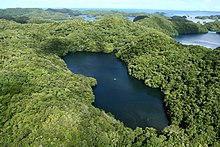海下水蚀洞
海下水蚀洞(英语:Anchialine pool,/ˈæŋkiəlaɪn/或/ˈæŋ.kiə.lin/),又称海水湖(英语:Marine lake),是地底与海洋相连的内陆水体,由于受到雨水、地下水及潮汐影响,内部存在淡水、半咸水及咸水并依照密度垂直分层,主要分布于热带或亚热带地区的喀斯特及火山地形。因为其环境的特殊性,其内部有有别于海洋或湖泊的生态系,并且拥有一些甲壳类的特有种生物,例如夏威夷红虾。[1]
语源
[编辑]英语“anchialine”一词由荷兰动物学家利克·霍采斯于1973年首度提出,该词由希腊文“ankhialos”衍生而来,意为“滨海的”,最初用来描述随着潮汐起落的陆上咸水池,[注 1][2]1997年Brock, Richard E.和Kam, Alan K.H.再添加“满潮时与其他水体分离”的原则。[注 2][3]此外,海水湖则是对湖面较大、且退潮时底部不干涸的海下水蚀洞的通俗称呼。[4]
形成及分布
[编辑]

海下水蚀洞主要分为两类:石灰岩质及火成岩质。前者为喀斯特地形因沉水作用形成(同时为石灰阱),又因热、亚热带地区石灰岩地形较发达,故此类海下水蚀洞分布多位于热带及亚热带,例如尤卡坦半岛、加勒比群岛、地中海石灰岩地区、帕劳群岛和印尼群岛等;后者为熔岩管被海水侵入,多分布于火山带,例如夏威夷群岛、科隆群岛、加那利群岛和萨摩亚群岛等。[4]
环境及生态
[编辑]
滨海地区的地下水层与海水并不会在海岸线交会,而是形成一个类似透镜的构造(淡水透镜体),来自陆地的淡水会覆盖来自海洋的咸水,并在其交界处产生盐跃层,厚度几公分至几米不等。[5]在盐跃层中盐度变化剧烈,大多由半咸水和淡水组成,且因密度的变化使得底部的咸水常年处于低氧环境中,即使在温带的冬季,淡水的密度仍较海水小。此外,由于底部的缺氧环境,行光合作用以进行初级生产的生物较少,取而代之的是硫还原菌透过将水中丰富的硫化氢转换为硫获取有机物,底部的水质会较顶部混浊。[6]
海下水蚀洞的生物组成与海洋类似,其中甲壳类的生物较为丰富,除了桨足纲的生物外(在1979年前被认为已灭绝,现存28种,活化石之一),亦有混足目[7]、平脚目[8][9]的特有种存在;然而部分种类的生物在地理分布上呈现隔离分布,例如桨足纲分布在加勒比海、加那利群岛及澳大利亚西海岸;原虾科分布在夏威夷、阿森松岛和百慕大群岛等地。这样的分布情形被认为可能与特提斯洋的存在相关,[10]但目前没有足够的遗传学证据证明这个猜想。[11]此外,夏威夷红虾(Halocaridina rubra)也是原生在海下水蚀洞中的生物,近年来人工养殖的数量有所成长。[12]海下水蚀洞中的鱼类包括来自胎鼬鳚科、塘鳢科、虾虎鱼科和合鳃鱼科,分布在科隆群岛、加勒比群岛、尤卡坦半岛、菲律宾、日本和澳大利亚等地。[13]
参考资料
[编辑]注解
[编辑]- ^ 原文:…At several occasions red coloured caridean shrimps have been reported from tropical land-locked saltwater pools. These pools are situated at some distance from the sea, but, because the level of the water rises and falls with the tides, must have subterranean connections with the sea.…It is suggested now to use the term "anchialine" (from the Greek anchialos, near the sea) to indicate this type of habitat, rather than to have to define it each time as "pools with no surface connection with the sea, containing salt or brackish water, which fluctuates with the tides".…
- ^ 原文:…Besides the classical definition of an anchialine pool (i.e., a body of water having a measurable salinity and showing tidal fluctuations but no surface connections to the sea), the working definition of an anchialine pool used here is that it is isolated from other adjacent bodies of water at the highest tides. If adjacent pools show surface connections on high tides, they are considered to be part of a poll complex. A complex may have a number of depressions or basins, which through lower tides may appear as individual pools but coalesce, at higher tides.…
参考资料
[编辑]- ^ Scott R. Santos. Patterns of genetic connectivity among anchialine habitats: a case study of the endemic Hawaiian shrimp Halocaridina rubra on the island of Hawaii (PDF). 分子生态学. 2006, 15 (10): 2699–2718. PMID 16911195. doi:10.1111/j.1365-294X.2006.02965.x. (原始内容存档 (PDF)于2020-07-16).
- ^ Holthuis, L.B. Caridean Shrimps found in Land-Locked Saltwater Pools at four Indo-West Pacific Localities (Sinai Peninsula, Funafuti Atoll, Maui and Hawaii Islands), with the description of one new genus and four new species. Zoologische Verhandelingen. 1978, 128 (1): 1–48 [2020-07-14]. ISSN 0024-1652. (原始内容存档于2020-07-14) (英语).
- ^ Brock, Richard E.; Kam, Alan H. Biological and water quality characteristics of anchialine resources in Kaloko-Honokohau National Historical Park (PDF). PCSU Technical Report. 1997, 112: 19 [2020-07-14]. (原始内容存档 (PDF)于2020-07-14) (英语).
- ^ 4.0 4.1 Becking, L.E.; Renema, W.; Santodomingo, N.K. Recently discovered landlocked basins in Indonesia reveal high habitat diversity in anchialine systems. 水生科学. 2017, 677: 89–105 [2020-07-14]. doi:10.1007/s10750-011-0742-0. (原始内容存档于2020-07-14) (英语).
- ^ S. Moore, Willard. The subterranean estuary: a reaction zone of ground water and sea water. 海洋化学. 1999, 65 (1-2): 111–125 [2020-07-15]. doi:10.1016/S0304-4203(99)00014-6. (原始内容存档于2020-07-15) (英语).
- ^ Culver, David C.; White, William B. Anchialine Caves. Encyclopedia of Caves. 阿姆斯特丹: 爱思唯尔. 2005. ISBN 978-0-12-198651-3.
- ^ J. K. Lowry & M. Yerman. Mictacea. crustacea.net. 澳大利亚博物馆. [September 3, 2007]. (原始内容存档于2012-05-14).
- ^ T. M. Iliffe. Antrisocopia prehensilis. The IUCN Red List of Threatened Species. 1996, 1996: e.T1784A7539000. doi:10.2305/IUCN.UK.1996.RLTS.T1784A7539000.en
 .
.
- ^ T. M. Iliffe. Nanocopia minuta. The IUCN Red List of Threatened Species. 1996, 1996: e.T14331A4433047. doi:10.2305/IUCN.UK.1996.RLTS.T14331A4433047.en
 .
.
- ^ Culver, David C.; White, William B. Biodiversity in Anchialine Caves. Encyclopedia of Caves. 阿姆斯特丹: 爱思唯尔. 2005. ISBN 978-0-12-198651-3.
- ^ Jaume, D.; Boxshall, G.A. Life in extreme ocean environments: anchialine caves. Marine Ecology. EOLSS. 2009. ISBN 978-1-84826-014-6.
- ^ Krause, Inken. Zwerggarnelen im Meerwasseraquarium. 德国明斯特: Natur und Tier Verlag. 2016. ISBN 978-3-86659-364-0.
- ^ Iliffe, Thomas M.; Kornicker, Louis S. Worldwide Diving Discoveries of Living Fossil Animals from the Depths of Anchialine and Marine Caves. Proceedings of the Smithsonian Marine Science Symposium. 华盛顿特区: 史密森尼学术媒体. : 269–280. doi:10.5479/si.01960768.38.1. (原始内容存档于2020-07-16).


